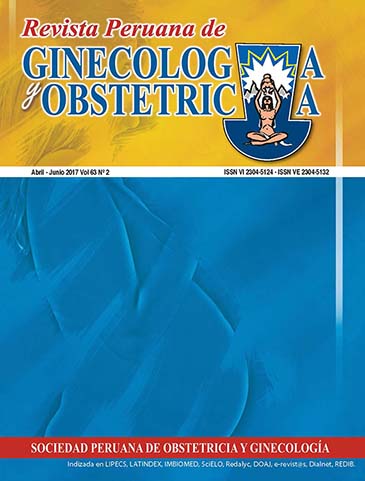Serum cholesterol in the second trimester of pregnancy as a predictor of preeclampsia
DOI:
https://doi.org/10.31403/rpgo.v63i1982Abstract
Objective: To establish the utility of serum concentrations of cholesterol in the second trimester of pregnancy as a predictor of the development of preeclampsia. Design: Case-control study. Setting: Hospital Central “Dr. Urquinaona”, Maracaibo, Venezuela. Participants: 504 nulliparous pregnant women between 17 and 20 weeks who assisted to Antenatal Consult. Main outcome results: General characteristics serum cholesterol concentrations and prognostic efficacy were evaluated. Results: Cases were 41 pregnant women who developed preeclampsia (Group A) and 463 pregnant women that were considered as controls (Group B). There were no differences in maternal age, gestational age and systolic and diastolic blood pressure at the moment of the ultrasound evaluation (p = ns). Gestational age at diagnosis of preeclampsia in group A was 35.0 +/- 3.2 weeks. There were significant differences in serum cholesterol concentrations between patients in group A (224.1 +/- 22.9 mg/dL) and patients in group B (185.0 +/- 20.1 mg/dL; p < 0.0001). A cut-off value of 200 mg/mL had a value under the curve of 0.89, sensitivity of 75.6%, specificity of 83.3%, positive predictive value of 29.2% and negative predictive value of 97.4%. Conclusion: Serum cholesterol concentrations in the second trimester could predict the development of preeclampsia in the pregnant women studied.Downloads
Downloads
Published
2017-07-11
How to Cite
Rivera-Pírela, R., Reyna-Villasmil, E., Mejia-Montilla, J., Santos-Bolívar, J., Torres-Cepeda, D., Reyna-Villasmil, N., & Fernández-Ramírez, A. (2017). Serum cholesterol in the second trimester of pregnancy as a predictor of preeclampsia. The Peruvian Journal of Gynecology and Obstetrics, 63(2), 163–169. https://doi.org/10.31403/rpgo.v63i1982
Issue
Section
Artículos Originales
















